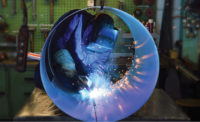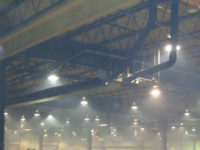Trouble controlling welding fumes?
Dense clouds, complaints & failing filters are warning signs

Keeping welding fumes to a minimum in the shop is essential for protecting people, property and productivity. Assuming you have some type of collection/extraction system in place to capture weld fumes, one or more of the following conditions will signal that this equipment is not doing an adequate job.
Signs of trouble
1. Visible fume and dust emissions: Some degree of visible fumes is inevitable during welding; but with a properly functioning extraction system, you should only see fairly light fumes through most of the shift. For example, in an ambient system that filters all the air in the shop, a light cloud may be visible during working hours but dissipate during break times or lunch when work ceases. If the cloud grows denser and denser throughout the day, there is probably an issue. It may be that you’ve outgrown the fume extraction system because of increased production, that it was improperly sized at the original time of installation, or that the equipment is malfunctioning.
2. Worker complaints: Welders complaining of health and discomfort problems are likely being exposed to an excessive level of fumes. Weld fumes are linked to a startling array of both short- and long-term health effects. Complaints should always be taken seriously and addressed as promptly as possible.
3. Failure to meet established air quality standards: Air quality testing using air sampling techniques is often performed to ensure that a shop is in compliance with OSHA regulations. OSHA has established permissible exposure limits (PELs) based on 8-hour time weighted average for hundreds of dusts, including the numerous metals contained in welding fumes. For further information, a good starting point is the OSHA Fact Sheet, “Controlling Hazardous Fume and Gases during Welding” (https://www.osha.gov/Publications/OSHA_FS-3647_Welding.pdf). By the time a shop fails an air quality test, heavy fume clouds and worker complaints will already be in evidence.
4. Premature plugging of filters and related equipment issues: If the filters in your fume extraction system are failing prematurely and requiring frequent change-out, the culprit may be excessive airflow for the filter media area. The collector may be too small for the job, or the filter pulse-cleaning system may not be working properly. The diaphragm and solenoid valves that regulate pulsing are critical for proper cleaning to occur, so proper valve operation is something to monitor during preventive maintenance inspections.
Compressed air system problems
The compressed air system is another potential source of trouble. If compressed air pressure is too low, the pulse cleaning system will not clean the filters properly. If the compressed air moisture content is too high, filter plugging or solenoid and diaphragm valve problems may result. Moisture problems in compressed air systems are especially prevalent when equipment located outside in winter climates experiences below freezing temperatures.
The role of cartridge dust and fume collection
A well-designed cartridge dust/fume collection system properly filters welding fumes and other hazardous contaminants, and the filtered air can either be exhausted outside or recirculated back into the facility for significant energy savings. These systems use self-cleaning mechanisms that pulse dirt off the filters, allowing units to run for extended periods between filter change-outs.
There are three general types of cartridge dust and fume collection systems used to clean up welding processes:
a) Source capture systems are popular for applications involving small parts and fixture welding. They will typically utilize a flexible source capture arm or a complete enclosure around the operation, such as an enclosure around a robotic weld cell.
b) Canopy hoods are often utilized if the footprint area is a medium size such as 12-ft x 20-ft or less. Curtains or hard walls may be added to the sides to create a booth or enclosure, although the ability to use such barriers may be limited by workspace requirements or the presence of other equipment or processes in the area.
c) Ambient systems that filter all the air in the shop using a central system or multiple smaller collectors are often chosen to serve larger areas because they allow a facility involved in multiple operations to capture all the fumes.
Conclusions
In recent years, we have seen an increasing number of larger companies in hot work operations setting their own guidelines for dust and fume exposure – guidelines that are sometimes far more stringent than OSHA PELs. These companies are voluntarily testing and monitoring exposure to ensure compliance with their own self-imposed air quality goals.
Taking a proactive approach to weld fume control will enable you to have a positive impact on your workers’ health – while avoiding the fines or shutdowns that can result from non-compliance. When you add energy savings from air recirculation to the equation, you achieve the trifecta of compliance, health/wellness and energy savings.
Looking for a reprint of this article?
From high-res PDFs to custom plaques, order your copy today!





